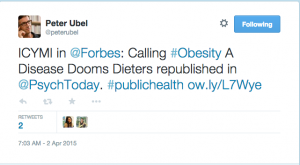So, where’s the substance of tweeting? Is this worth our time? Here’s the case for creating your account.
Some disappointing news
In May 2012 Harvard Business Review published “What makes a good tweet?” from a study by researchers at Carnegie Mellon University, MIT and Georgia Tech. (1)
The researchers asked 1,443 users to rate the quality of 43,738 tweets. There was a disappointingly low number, just 36% of the tweets were “worth reading.” In general, the respondents were a tech-centric group. We did learn that a key is to be aware of the audience and to be clear, to add more content and not be so cryptic, and not to overuse hashtags. That goes for abbreviations and mentions, too.
Here were the best types of tweets these authors found. We’ve added some ideas and examples from medicine.
- random thoughts but not the sort that “who cares?” might be the response

- self-promotion (surprisingly) with a link to one’s own work
- questions to followers for the purpose of crowdsourcing. [I see very few of these]. Consider:
- arrival in the city of your annual symposium and you tweet “Looking for recommendations for a local restaurant! #Conference #CityName”
- ask for feedback
- ask what’s uncovered by your project idea
- create a contest or a poll
- information sharing but avoidance of retweeting old news
Here’s a tweet posted by Dr. Van Houtven about a publication <24 hours since showing up online.

Yet quantitative data reveals an emerging presence
Earlier (Part 1) we showed stats from the annual assembly of AAHPM 2015 – over 16,000 tweets! These “impressions and influencers” will make more sense now that you see how the hashtag is used to aggregate all the posts for analysis. The source is the Healthcare Hashtag Project produced by Symplur.com. To join, the conference must submit a request and choose a hashtag. The outcomes are infographics and data showing the reach of the posts and who’s posting.
There’s already a buzz starting for SGIM 2015. From #SGIM15 in Symplur you can view the “top ten mentions” and “top 10 by tweets” and see all the participants in this media.
Recognize anyone from Duke in this picture, a portion of a collage by Symplur of all those tweeting last year?

Look far right for @EvidenceBasedMD (Daniella Zipkin, MD)!
Notice also the growth of readership of Twitter in Medicine. These Duke people have hundreds of followers: Peter Ubel (GIM and Fuqua Business School) @peterubel 3,845, Matt Sparks (Nephrology) @Nephro_Sparks 1,462, Deborah Fisher (GI) @DrDeborahFisher 744 (viewed online 4.3.2015).
And, publications add evidence
Notice the growth of academic publications embracing Twitter. Try searching PubMed using the keyword “twitter.” Check out this personal compilation via this public link to MyNCBI: http://goo.gl/bSuh9u. Topics in these journals included: live-tweeting in medicine; an experience of a palliative care journal club on twitter; a twitter based intervention for smoking cessation; twitter and health science research, on and on.
Next week, the last in our series, will be tips for live-tweeting a healthcare conference, all as prep for #SGIM15 in Toronto at the end of the April.
You can probably tell we (@Duke_GIM) are really novice at this. Have you guessed that there are three of us posting for a grand total of 186 tweets since opening our account? Thanks for tolerating us. We acknowledge some may be following out of social obligation, others, we hope, because we have something to say. We want to build our community, to learn from you and share with you. We’ll do our best to adhere to these tips and show you “the beef”!
Won’t you mention us @Duke_GIM?
Here’s the link to our entire Twitter in Medicine Series.
- Andre P, Bernstein MS, Luther. Who Gives a Tweet? Evaluating Microblog Content Value. Computer Supported Cooperative Work, February 11-15, 2012; author’s copy here.

